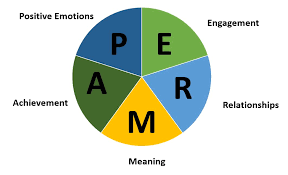
Well-Being and the Five ‘Happy’ Lives
Well-Being and The PERMA Model
 Seligman (2011) argues that well-being is enhanced through thriving in one or more pillars of well-being. His model, often referred to as the PERMA Model, consists of Positive Emotions, Engagement, Relationships, Meaning, and Accomplishment (or Achievement). The more we thrive in each of these, the higher our well-being, according to this theory, although we will each have preferences and strengths that lean toward some more than others.
Seligman (2011) argues that well-being is enhanced through thriving in one or more pillars of well-being. His model, often referred to as the PERMA Model, consists of Positive Emotions, Engagement, Relationships, Meaning, and Accomplishment (or Achievement). The more we thrive in each of these, the higher our well-being, according to this theory, although we will each have preferences and strengths that lean toward some more than others.
These pillars are also pathways to happiness, or what he referred to as the 'happy' lives, with the recognition that happiness is difficult to define and therefore difficult to measure. These happy lives were introduced by Seligman (2004) in an initial group of three, including the Pleasant Life (referring to the enhancement of well-being through a focus on positive emotions), the Good Life, or what I refer to as the Engaged Life (focused on improving well-being through engagement), and the Meaningful Life (focused on enhancing well-being through finding meaning in how we live). The other two relate to the Relational Life, (a focus on positive relationships as a means to build well-being) and the Accomplished Life (focused on enhancing well-being through one’s accomplishments).
We use our strengths in these areas to increase our ability to thrive and we use resilience and other forms of psychological capital to help us overcome adversity or to better navigate our present and future. See our blog on Building Psychological Capital, Hope, Self-Efficacy, Resilience, and Optimism.
Thriving and the Five 'Happy' Lives
First, let me repeat that happiness is difficult to define because it is very personal. What brings happiness to one person, may have little impact or even a negative impact on someone else. The idea behind much of positive psychology is looking at what works for you, what brings you happiness, and how you can use your strengths to thrive. I've tried to describe the five happy lives below, but there is overlap and it only matters if you can apply it to your own life and your own happiness.
 The Pleasant Life
The Pleasant Life
The Pleasant Life stems from the Well-Being Pillar of Positive Emotions. Thriving in this pillar represents the experience of as many positive emotions as possible. The Pleasant Life is sometimes related to hedonism because it focuses on bringing as much joy and gratitude into your world as possible. Those who thrive living the Pleasant Life might say that they work to enhance their positive emotions, including joy, gratitude, and hope, and may spend time laughing, sharing their joy with others, or contemplating their good fortunes.
 The Engaged Life
The Engaged Life
The Engaged Life stems from the Well-Being Pillar of Engagement. Thriving in this pillar represents engagement in activities that maximize your strengths. People who thrive in living the Engaged Life often find themselves in flow (see our blog article, Flow: A State of Full Engagement). Flow is a point in time when our focus, our strengths, our lives are working in synchrony, sometimes causing us to lose track of time. Consider reading a good book and being so engaged in the story that the world around you seems to disappear or listening to your favorite band on the bus ride home and missing your bus stop. Being engaged can be short term (listening to your favorite song) to moderate term (building cabinetry or creating art) to very long term (engaging in a life-long activity or hobby).
 The Meaningful Life
The Meaningful Life
The Meaningful Life stems from the Well-Being Pillar of Meaning. Thriving in this pillar involves attention to the greater meaning behind your activities and interactions with the world. The Meaningful Life has been associated with religion and spirituality, altruism and volunteer work, and eudemonia, or the bringing about of happiness through experiences of meaning and purpose.
 The Relational Life
The Relational Life
The Relational Life stems from the Well-Being Pillar of Positive Relationships, or simply Relationships. Thriving in this area focuses, obviously, on our relationships with others. Some who thrive in this area would say that focusing on small groups like family and close friends brings them great happiness. Others may prefer larger groups and gatherings. Being introverted or extraverted does not impact your ability to thrive in this area, just how you might go about thriving.
 The Accomplished Life
The Accomplished Life
The Accomplished Life stems from the Well-Being Pillar of Accomplishment or Achievement. Thriving in this area means a focus on goal setting and goal achievement. Those who thrive in this area might focus a lot of attention on deliberate practice and self-improvement related to their activities, careers, and professional hobbies, including activities related to business, sports, music, dance, art, writing, research, teaching, and other areas of focus.
Find Your Happy Life
Happiness is in the eye of the beholder, so the saying goes. Think about what brings you happiness and how that may fit into Seligman's PERMA Model of Well-Being. Ask yourself:
How important are positive emotions like joy and gratitude to my happiness and well-being and what can I do to thrive in this area?
How important is engaging with the world to my happiness and well-being and what can I do to thrive in this area?
How important are my relationships with others to my happiness and well-being and what can I do to thrive in this area?
How important is finding meaning in my life to my happiness and well-being and what can I do to thrive in this area?
How important are accomplishments and achievement to my happiness and well-being and what can I do to thrive in this area?
References
Seligman, M. (2004). The new era of positive psychology. Ted Talk video. Retrieved from https://www.ted.com/talks/martin_seligman_the_new_era_of_positive_psychology?language=en#t-541427.
Seligman, M. (2011). Flourish (A Visionary New Understanding of Happiness and Well-Being). New York, NY: Free Press.